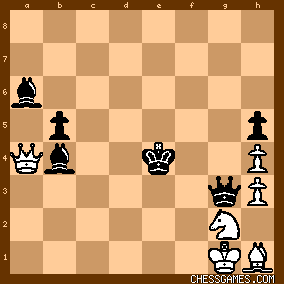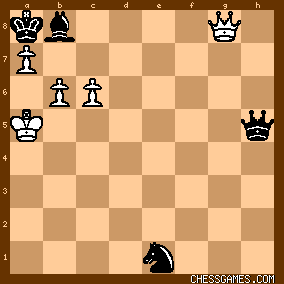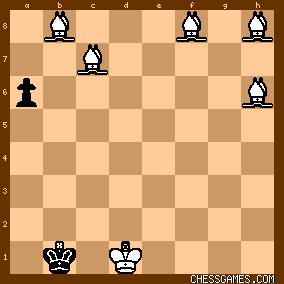|
< Earlier Kibitzing · PAGE 15 OF 914 ·
Later Kibitzing> |
Nov-09-06
 | | Phony Benoni: WHITE TO PLAY AND WIN
(Composed by B. A. Bron, 1934. Published in Chessboard Magic by Irving Chernev, #29.)

click for larger view
OK, back to work. Here Black's only desire is to win one of the knights. Be careful what you wish for... <1.Nd2+ Kd3 2.Ne1+ Ke2 3.Bb5+ Kd1> (Not yet, capturing either knight allows a winning fork with 4.Nf3+.) <4.d7 Bxd7 5.Bxd7 Be5+ 6.Kb1 Bc3 7.Ne4 Bxe1 8.Bg4#!>

click for larger view |
|
Nov-11-06
 | | Phony Benoni: WHITE TO PLAY AND DRAW
(Composed by G. M. Kasparyan, 1935. Published in Chessboard Magic by Irving Chernev, #30.)

click for larger view
Shall we dance?
<1.Nf4 Qxg3+ 2.Ng2+ Ke4 3.Qxa4>

click for larger view
(So that 3...bxa4 is stalemate.) <3...Qh2+> (So that 4.Kxh2 relieves the stalemate, but..) <4.Kf2 Qg1+ 5.Kg3 Qf2+ 6.Kh2 Qg3+ 7.Kg1> And draws! |
|
Nov-12-06
 | | Phony Benoni: WHITE TO PLAY AND WIN
(Composed by T. B. Gorgiev, 1929. Published in Chessboard Magic by Irving Chernev, #31.)

click for larger view
This looks easy. Just sacrfice some stuff and Black can't stop the f-pawn. <1.f5+ Kxf5 2.Nh6+ Rxh6 3.f7 Ng5+! 4.Bxg5 Kxg5> (Ah-ha!. I see the trick--5.f8Q Rf6+. Well, we know what to do about that.) <5.h4+! Kg6!>

click for larger view
(Hmmm. We seem to have goofed. Making a queen is stalemate, and a rook does no more than draw. Any other volunteers?) <6f8B!>
One can just hear the rook screaming, "Don't leave me! Don't leave me!" But to no avail... |
|
Nov-13-06
 | | Phony Benoni: WHITE TO PLAY AND DRAW
(Composed by V. A. Korolikov, 1930. Published in Chessboard Magic by Irving Chernev, #32.)

click for larger view
If any of you find White's second move without computer assistance, I will be impressed. I might even be slightly impressed if you find it with computer assistance and don't think your analyst is suffering from the horizon effect. <1.Nb3 d3 2.Bg5!!!>
Certainly looks futile.
<2...hxg5 3.Kh6!! c1Q 4.Nxc1 d2 5.Nb3 d1Q>

click for larger view
<6.Bc2! Qg4! 7.Bf5!> And all is revealed. 2.Bg5 sealed off the queen's escape along the g-file, while 3.Kh6 kept the king safe from checks as it guards h5. Meanwhite, Black's queen is face with forks and skewere all over the place, such as 7...Qa4 8.Bd7+ Kxd7 9.Nc5+. Therefore: <7...Qd1! 8.Bc2!>
And draws by the papparazzi maneuver! |
|
Nov-14-06
 | | Phony Benoni: WHITE TO PLAY AND WIN
(Composed by A. S. Gurewitz, 1932. Published in Chessboard Magic by Irving Chernev, #33.)

click for larger view
According to endgame theory, B+2Ns normally defeats B though there are exceptions. Will this be one of them? <1.N6c7 a1N+>
Necessary to stop Bb6#.
<2.Kb2 Nb3!>
Since the knight cannot be salvaged, Black goes for stalemate. <3.Kxb3 Be3! 4.Bh2 Bg1 5.Bf4! Be3>

click for larger view
This is getting annoying, but what can White do about it! <6.Nb6!!>
Simply winning after 6...Bxb6 7.Bd2#, 6...Bxf4 7.Nc4#, or 6...Kxb6 7.Nd5+. And that's why 5.Bf4 got an exclam--the Black bishop had to be on precisely the e3 square for the last line to work. |
|
Nov-15-06
 | | Phony Benoni: WHITE TO PLAY AND WIN
(Composed by K. A. L. Kubbel, 1925. Published in Chessboard Magic by Irving Chernev, #34.)

click for larger view
Three passed pawns! Which pawn will deliver the decisive blow?
<1.e7! Bxe7 2.b7 e4+ 3.Kxc3 Bf6+ 4.Kb4! Be5 5 g7 Be6 6.c4#!>

click for larger view
Naturally. |
|
Nov-16-06
 | | Phony Benoni: WHITE TO PLAY AND DRAW
(Composed by M. B. Newman, 1914. Published in Chessboard Magic by Irving Chernev, #35.)

click for larger view
Sometimes you just have to attack.
<1.Nf6>
Keeps the king away from the safety of g4, threatens 2.e4+ Kxf6 3.Bg5#--and there's this little matter of an en prise queen to deal with as well. <1...Kxf6 2.e4 e5>
Ah, we've gotten into an "e4 e5" line. Maybe there are chances after all. <3.Bg7+ Ke6 4.f5+ Kxd6 5.Bf8+ Qe7>

click for larger view
Now that's progress! All we have to do now is take the queen--and lose the pawn ending. Oh, wait... <6.f6! Qxf8>
Stalemate. |
|
| Nov-16-06 | | Resignation Trap: Remember the good ol' days, when we exchanged unannotated games to each other? I just posted one such game on The Kibitzer's Café . |
|
Nov-17-06
 | | Phony Benoni: WHITE TO PLAY AND DRAW
(Composed by F. M. Simkovitsch, 1935. Published in Chessboard Magic by Irving Chernev, #36.)

click for larger view
So, the question is--how do we lure the Black pawn to f5? <1.Rc4 b2 2.Rxc2 bxa1Q 3.f3+ Kg1 4.Kh3 Nxe3 5.Rh2>

click for larger view
A kind of mutual zugzwang. Black can't move the queen due to knight forks, the Ne3 must guard Rg2#, and the Nb1 must stop Rh1+ winning the queen. On the other hand, White can't keep his position intact either, and Black has more pawn moves available. <5...f5 6.f4 d5 7.a3! Qxa3> Well, what else?
<8.Rg2+! Nxg2>

click for larger view |
|
Nov-18-06
 | | Phony Benoni: WHITE TO PLAY AND WIN
(Composed by A. O. Herbstman, 1935. Published in Chessboard Magic by Irving Chernev, #37.)

click for larger view
Not as easy as it looks, as 1.axb7 is answered by 1...Bf8+ and 2...Bd6. The play revolves around taking this resource away from Black. <1.d4+ Ke4>
1...Ke6 2.Bg4+ f5 3.Bxf5+, and Black's king must give up protection of d6 or block the bishop with 3...Ke7. After the text, 2.axb7 is still premature because of 2...Bxd4+ and 3...Be5. <2.Bf3+ Kd3>
Still too early: 3.axb7 Bxd4+ 3.Kd6 f6 and 4...Be5+.
<3.Be2+ Ke4 4.axb7! Bxd4+ 5.Kc4! Be5>

click for larger view
So Black stops the pawn, while White...
<6.Bd3#!>
...stops Black.
|
|
Nov-19-06
 | | Phony Benoni: WHITE TO PLAY AND WIN
(Composed by V. and M. Platov, 1911. Published in Chessboard Magic by Irving Chernev, #38.)

click for larger view
It's easy enough to skewer the king and queen. You just have to get them on the right squares. <1.Qd4+ Ka3>
1...Ka5 2.Qd8+ Kb4 3.Qf8+ and 4.f7 wins.
<2.Qa1+ Kb4 3.f7! Qxa1 4.f8Q+! Ka5> 4...Kc3 5.Qf6+ wins the queen along the diagonal.
<5.Qd8+ Kb4 6.Qd6+ Ka5 7.b4+ Ka4 8.Qxa6+> Winning the queen along the file instead. |
|
Nov-20-06
 | | Phony Benoni: WHITE TO PLAY AND DRAW
(Composed by K. A. L. Kubbel, 1930. Published in Chessboard Magic by Irving Chernev, #39.)

click for larger view
Another one of those B+2Ns vs. B endings. This time, the defense holds. <1.Bf2 Bxb4 2.d6 Nxd6+> 2...Bxd6 3.Kf3 Nf4 4.Bg3 draws.
<3.Kf3 Ne1+ 4.Ke2 Nc2 5.Kd3 Na3 6.Bd4+ Kg6 7.Bc3>

click for larger viewAnd draws by shuttling between c3 and d4, as Black's bishop can neither escape nor exchange. |
|
Nov-21-06
 | | Phony Benoni: WHITE TO PLAY AND WIN
(Composed by Gm. M. Kasparyan, 1936. Published in Chessboard Magic by Irving Chernev, #40.)

click for larger view
In which Black is reduced into shuffling off into checkmate. <1.Rd1 Kb3 2.Nd2+ Kc2 3.Ra1 Kb2 4.Nf4 Kxa1 5.Nd3>

click for larger view
And the question becomes whether the White king can invervene before Black queens a pawn. <5...b5 6.Kg4 b4 7.Kf3 b3 8.Ke2 b2 9.Nb3+ Kb1 10.Kd1 a1Q>

click for larger view
Black has won the battle--but loses the war.
<11.Nb4! Qa2 12.Nd2+ Ka1 13.Nc2#> |
|
Nov-22-06
 | | Phony Benoni: WHITE TO PLAY AND WIN
(Composed by A. S. Gurewitz, 1932. Published in Chessboard Magic by Irving Chernev, #41.)

click for larger view
A duel wherein White wins a piece, and Black does his best to win it back. As usual, e4! wins. <1.Nf3+ Ke4 2.Ng5+ Ke5 3.Nxf7+ Ke6 4.Nh8> Not 4.Ng5+ Ke7 and 5...Be3+.
<4...Kd7 5.Nf6+ Kc7 6.Ba6 Bd4 7.Nxd5+ Kd6 8.Ng6 Kxd5>

click for larger view
Time for the magic move!
<9.e4+! Kxe4>
9...Ke6 10.Bc8+ preserves the pawn and wins.
<10.Bb7#!>
|
|
Nov-23-06
 | | Phony Benoni: WHITE TO PLAY AND WIN
(Composed by K. A. L. Kubbel, 1925. Published in Chessboard Magic by Irving Chernev, #42.)

click for larger view
An older, distant cousin of the manuever which has become known as "Mitrofanov's Deflection". <1.Rg6 Nf6 2.Qh6+ Kf7 3.Rxf6+ exf6 4.Qh7+ Ke6 5.f5+ Kd6 6.c5+ Kd5> 
click for larger view
Now what? 7.Qf7+ Ke4 allows the king to escape, and 7.Kd3 Qa6+ leads nowhere. What else is there? <7.Qg8+!! Qxg8 8.Kd3!> And Black cannot stop 9.c4#!
For comparison, here is the climactic moment of Mitrofanov's famous study from 1967, starting after Black's 6th move:

click for larger view
<7.Qg5!! Qxg5+ 8.Ka6 Bxa7 9.c7!!> Wow. With 2 pawns vs. Q+B+N White plays a quiet move, threatening two mates. <9...Qa5+ 10.Qxa5 Kb7 11.bxa7> And one of the pawns queens.
|
|
| Nov-23-06 | | siilarsi: You have by far the funniest biography I have read on Chessgames.com, but maybe I have just been drinking too much coffee, which would make it the coffee talking, and coffee while delicious and nutrious have been proven to lack common sense. |
|
Nov-23-06
 | | Phony Benoni: <siilarsi> Thanks for the kind words. I would have to agree that coffee does warp the brain, which is why I never touch the stuff. However, in my case, such abstinence doesn't seem to have helped much. |
|
Nov-24-06
 | | Phony Benoni: WHITE TO PLAY AND DRAW
(Composed by L. Semisashenov, 1940. Published in Chessboard Magic by Irving Chernev, #43.)

click for larger view
Considering the position of the White king, you can put your ChessBucks on a stalemate. But the actual method is pretty. <1.Bg1 a2 2.Bh7! b1Q 3.Bd4+ Qb2 4.Bh8!>

click for larger view
And Black can spend the rest of the time control deciding whether to stalemate White with 4...Qxh8, or get mated after any other move. |
|
Nov-25-06
 | | Phony Benoni: WHITE TO PLAY AND WIN
(Composed by M. B. Newman, 1913. Published in Chessboard Magic by Irving Chernev, #44.)

click for larger view
In which Black is cursed with a succession of bad choices. <1.Bb5+! Qxb5>
(1...Nxb5 allows 2.Nc5+ and mate next move, while 1...Kxb5 runs into 2.Nd6+.) <2.Nc3+ Kxa3 3.Nxb5+ Nxb5>

click for larger view
And Black's knight will be able to stop the h-pawn. Unfortunately, it can't stop the knight as well. <4.h6 Nd6 5.Nc4+!>
And wins, one way or the other.
All very neat and clean-cut. However, that old spoilsport tablebase points out that, in the second diagram, White wins more easily with 4.Nf5, cutting off Black's knight from the d6 square. 4.Nc4+ and 4.Nc2+ work as well, though a good deal trickier. |
|
Nov-26-06
 | | Phony Benoni: WHITE TO PLAY AND WIN
(Composed by A. A. Troitzky, 1924. Published in Chessboard Magic by Irving Chernev, #45.)

click for larger view
In which things go from bad to worse for BLack's bishop. <1.f6! gxf6>
1...g6 2.Kc7 Bd8 3.Bd4, and the bishop is going nowhere. <2.Kb7 Bd8 3.Kc8 Be7 4.Kd7 Bf8 5.Be3+!> Not so fast, big guy!
<5...Kc7 6.Ke8 Bg7 7.Kxf7 Bh8 8.Kg8> And that's that. Note, by the way, the g3-pawn's reason for existence; without it, Black could draw with 8...Kb3. Then again, Troitzky might have been able to find a win. Remember this famous composition by him?

click for larger view
Yes, White can win this! The main line goes <1.Bce5 a5 2.Ba1 a4 3.Bbe5 a3 4.Kd2 Ka2 5.Kc3 Kxa1 6.Kb3+ Kb1 7.Ba1 a2 8.Kc3 Kxa1 9.Kc2#> |
|
Nov-27-06
 | | Phony Benoni: WHITE TO PLAY AND WIN
(Composed by B. M. Birnov, 1935. Published in Chessboard Magic by Irving Chernev, #46.)

click for larger view
A different kind of double attack. In the midst of a fierce struggle to achieve a decisive material advantage, White suddenly switches over to a mating attack. <1.Be4 f5 2.Bxf5 Nh4 3.Bf4+ Kc3 4.Bxg4 Bb6 5.Bg3 Ng2 6.Bf3 Ne3 7.Kb5! Bd4>

click for larger view
The bishop and knight are safe--but that proves little consolation for Black's king. <8.Be1+ Kd3 9.Nb4#>
|
|
Nov-28-06
 | | Phony Benoni: WHITE TO PLAY AND DRAW
(Composed by A. Kowalenko, 1927. Published in Chessboard Magic by Irving Chernev, #47.)

click for larger view
One fascination of chess is the way in which even simple postions can contain the most remarkable resources. <1.Kc6 Kb4 2.Kd5 Kc3 3.Ke5 e3>

click for larger view
It's a good exercise to determine why these moves were necessary; for instance, Black had to delay ...e3 until his king was within reach of d2. Now, it seems White has only bad choices: 4.fxe3 fxe3 5.Kf4 Kd2 6.Kf3 f4!, with zugzwang.
4.f3 Kd2 wins easily
4.Kxf4 exf2 and the pawn promotes.
<4.Kxf4! exf2 5.Ke3!!>

click for larger view
The point: 5...f1Q or 5...f1R are stalemate! Where did that come from? <5...f1B>
He has to promote to something or lose the f2-pawn, and after 5...f1N+ 6.Kf4 Black can no longer protect the vital final pawn. <6.Kf4 Bh3 7.e4>
and draws, as the last pawn comes off. |
|
Nov-29-06
 | | Phony Benoni: WHITE TO PLAY AND WIN
(Composed by B. A. Bron, 1939. Published in Chessboard Magic by Irving Chernev, #48.)

click for larger view
Hey, Rocky, Watch me pull a rabbit out of my hat!
<1.c5+ Qxc5 2.Na4+ bxa4 3.Be3 Ka5!>

click for larger view
But that trick never works!
<4.b4+! Qxb4 5.Bd2>
This time for sure! Presto! |
|
Nov-30-06
 | | Phony Benoni: WHITE TO PLAY AND DRAW
(Composed by F. Lazard, 1930. Published in Chessboard Magic by Irving Chernev, #49.)

click for larger view
Wherein Black gets good news and bad news.
<1.h5>
Threatening 2.h6 winning. In what follows, Black must keep capturing or White will break through. By the way, note the timing throughout; any variation in White's moves will permit Black to escape. <1...gxh5 2.g6 fxg6 3.e6 dxe6 4.c5 dxc5 5.a6 bxa6 6.b6 axb6>

click for larger view
The good news is that Black has tied the record for most passed pawns ahead. The bad news... |
|
Dec-01-06
 | | Phony Benoni: WHITE TO PLAY AND WIN
(Composed by B. F. Didrichson, 1936. Published in Chessboard Magic by Irving Chernev, #50.)

click for larger view
Hippity-Hop!
<1.b6 Re1 2.Nb3 Rd1 3.b7 Rd8 4.Nd4+>

click for larger view
<4...Kxg4 5.Nc6 Rh8 6.Kxe7 Rg8 7.Nd8 Rg7+ 8.Nf7 Rg8 9.Nh6+> And the fork wins. Now, my question is this: in the second diagram, what happens if Black plays 4...Kg3 instead of walking into that fork? As long as Black keeps attacking the pawn, he'll be able to take it should White win the rook for his b-pawn. |
|
 |
 |
|
< Earlier Kibitzing · PAGE 15 OF 914 ·
Later Kibitzing> |





